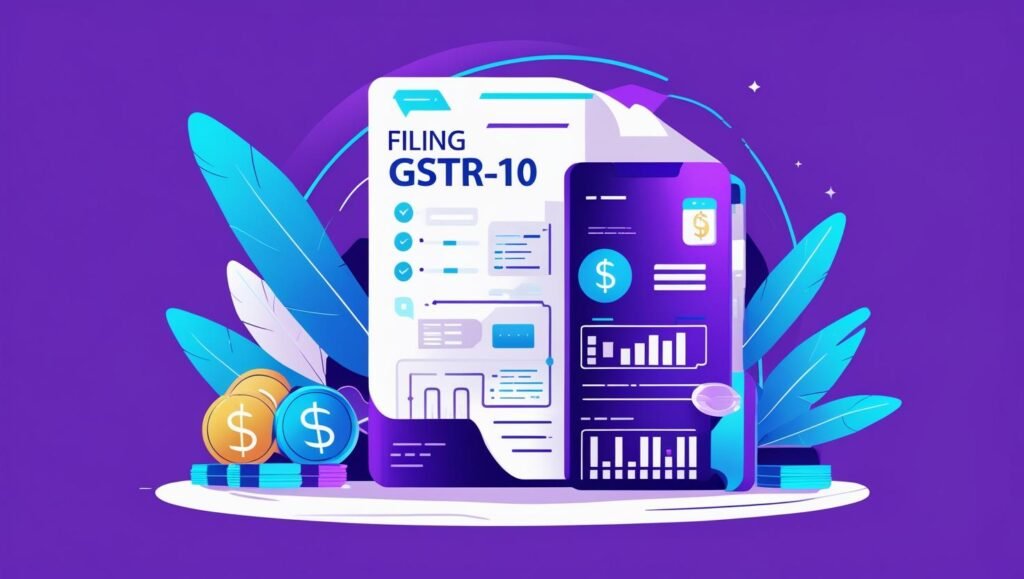Businesses often undergo changes that necessitate the cancellation or surrender of their GST registration. Whether due to the closure of a business, a change in its constitution or no longer meeting the turnover criteria, this process requires a final settlement of all tax liabilities. This final settlement is completed by filing a specific return known as GSTR-10. This article breaks down the purpose, applicability and procedural details of filing the GSTR-10 return, serving as a comprehensive guide for taxpayers navigating this final compliance step.

GSTR-10 is a final, one-time return that a registered person must file when their GST registration is either canceled or surrendered. This return is a crucial step for a clean exit from the GST system. Its primary purpose is to ensure that all outstanding tax liabilities, particularly those related to the Input Tax Credit (ITC) on the closing stock, are settled with the government. Filing this return correctly and on time is essential for a proper and lawful closure of a business’s GST obligations.
Filing GSTR-10 is mandatory for all registered taxable persons whose GST registration has been canceled or surrendered. However, the following categories of taxpayers are exempt from this requirement:
The GSTR-10 return must be filed within three months from the date of the GST registration cancellation or the date of the cancellation order, whichever is later. For instance If your GST registration was canceled on January 1, 2025 and you received the official cancellation order on January 5, 2025, the due date for filing GSTR-10 would be April 5, 2025.
Penalty for Late Filing: If GSTR-10 is not filed within the specified due date, a tax officer will issue a notice requiring the taxpayer to file the return within 15 days. If the taxpayer still fails to comply, the tax officer can proceed with a final assessment and pass an order for the cancellation, including the amount of tax payable along with interest and a penalty. The late fee is ₹100 per day for CGST and ₹100 per day for SGST, which means a total of ₹200 per day of delay.
The GSTR-10 form is divided into several sections, with some details being auto-populated based on your GST registration data. The key sections where information must be manually furnished are:
The accurate reporting of closing stock is vital to avoid future disputes. Here’s a breakdown of the specific rules:
Q1: What is the difference between a final return (GSTR-10) and an annual return (GSTR-9)?
An annual return (GSTR-9) is filed once a year by all regular taxpayers to reconcile their annual GST liability. A final return (GSTR-10) is a one-time return filed only by taxpayers whose GST registration has been canceled or surrendered to close their tax account.
Q2: Can I file a Nil GSTR-10 return?
Yes, you can file a Nil GSTR-10 return if you have no closing stock on which Input Tax Credit was availed and no other liabilities to report.
Q3: Is filing GSTR-10 mandatory even if I have no stock?
Yes, GSTR-10 is a mandatory final return for all non-exempt taxpayers whose registration has been canceled. Even with no stock or tax liability, the return must be filed to formally close the registration.
Filing the GSTR-10 return is the final and non-negotiable step in the GST registration cancellation process. It serves as a comprehensive statement of a taxpayer’s closing liabilities and is essential for a clean and legal closure. By understanding the due dates, the applicability and the specific requirements for reporting closing stock and ITC reversal, taxpayers can ensure full compliance. Timely and accurate filing of GSTR-10 helps in avoiding penalties, fines and the hassle of further legal proceedings, allowing for a smooth and conclusive exit from the GST regime.
For hassle-free GSTR-10 form filing and compliance, Filingg.com offers expert services to ensure your business thrives. For more details, contact 7791910007 or info@filingg.com today!
WhatsApp us